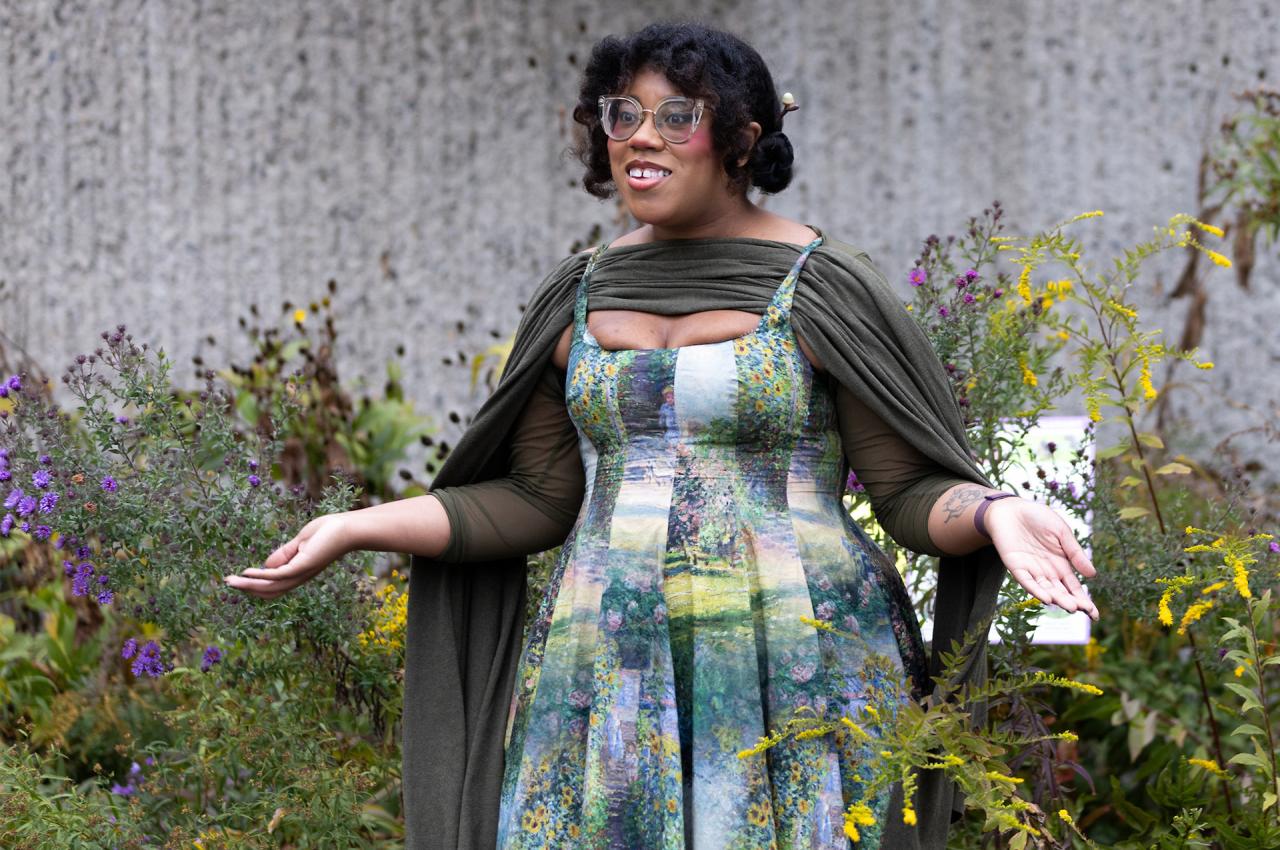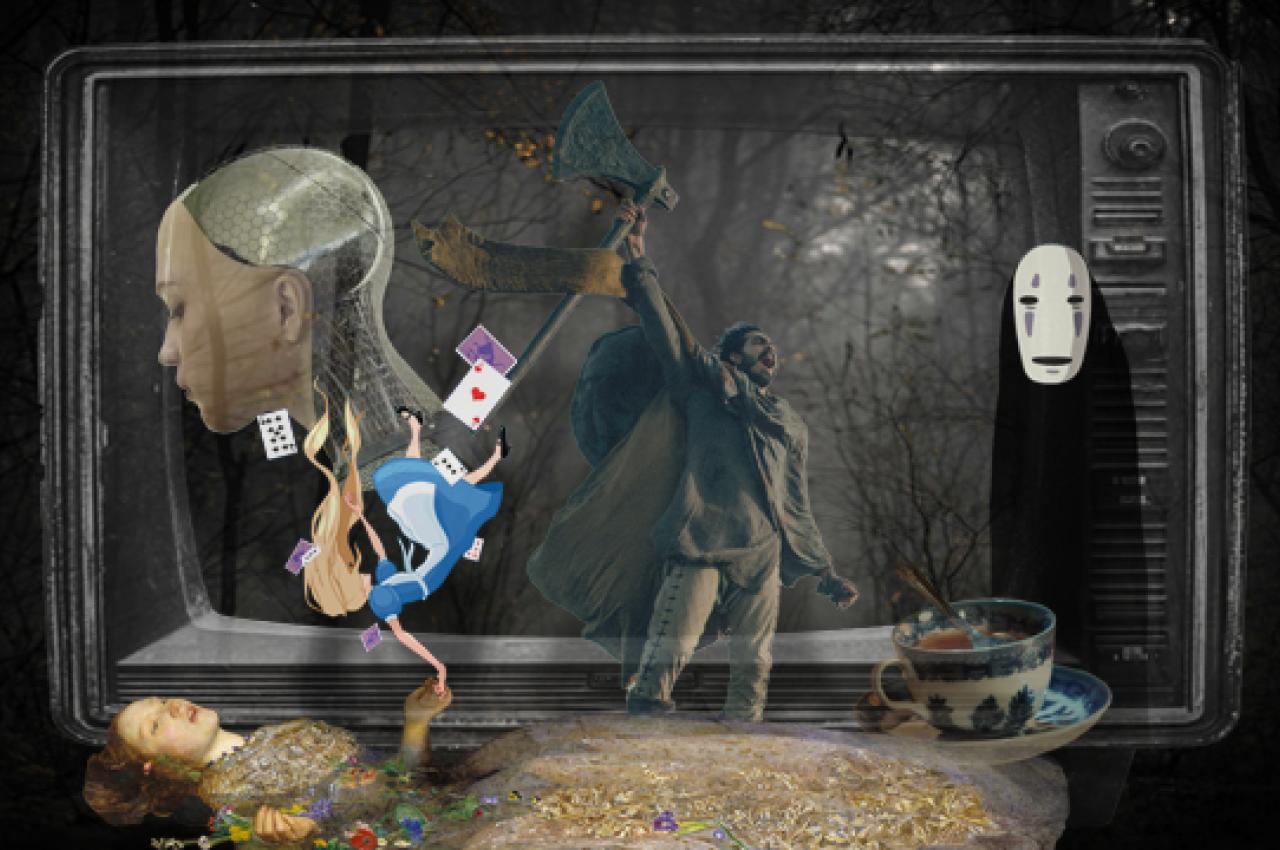The ‘Black Forager’ Nibbles the Campus
Wearing a green dress with a pastoral print, a faux acorn and butterfly tucked into her hair, Alexis Nikole Nelson, the internet-famous forager, was giving off serious Mother Nature vibes. It was her first visit to the Medford/Somerville campus, but she soon found snacks in the shrubs and flowerbeds.
With delight, she took a pinch of small white flowers she identified as sweet alyssum. “You’ve got a little bit of nectar from the flowers, but then you’ve got a little bit of mustard from the green parts,” she said as she popped the sprig in her mouth. “In a salad, they’re delightful.”
From a hedge behind Ballou Hall, she plucked what looked like a bright red berry but is technically an aril, the fruit of the yew tree. While the gooey red flesh of the aril is edible and reminds Nelson of lychee, the seed inside—like the leaves and rest of the yew—is toxic.
“It’s probably the most poisonous plant on this campus,” she said, highlighting an important lesson of foraging: “Danger is everywhere.”
Nelson is a chef and outdoor educator known on Instagram and TikTok as the Black Forager. She posts about finding and cooking wild plants, mushrooms, and seaweed while sharing the historical connection foraging has to African American and Indigenous food traditions. Her efforts have won her more than 5 million followers as well as a 2022 James Beard Award for best social media account.
Nelson’s snacking tour of Tufts on October 29 was followed by a talk at the Cabot Intercultural Center, part of the Jonathan M. Tisch College of Civic Life Solomont Speaker Series. The event was co-sponsored by the Tufts Pollinator Initiative.
Here are a few takeaways from her tour and talk.
Foraging in America has strong connections to Black history.
Foraging was a crucial survival skill for enslaved people, with much knowledge transferred between the Indigenous and Black communities. “Enslaved Black people got really good at fishing, trapping, and foraging” to supplement their meager plantation rations, Nelson said, “because you can’t survive on moldy cornbread and fat.”
After the end of enslavement, plantation owners still needed workers but found that poor people who could live off the land had little incentive to work for them for low pay. So many locales passed laws that made trespassing a criminal offense, which means if you didn’t own the land, you could be arrested for foraging, fishing, or trapping on it. Foraging in America saw a decline, Nelson said, noting that some communities, especially in Appalachia, kept the traditions alive.
World War II saw a brief resurgence of foraging as Americans were encouraged to be self-sufficient. But then the arrival of refrigerators, frozen foods, and suburban spawl in the 1950s made foraging seem like a poor person’s pursuit, and it fell away.
“That being said, there’s been a really beautiful reclamation of foraging knowledge in the last couple of decades that gets to proliferate so easily because of the internet and because of wonderful and curious people like you guys,” she said to the crowd. “And so we’ve kind of reached this point where foraging has become kind of trendy again.”
Get to know your plant.
It’s smart to be afraid of eating a plant you don’t know well.
“That energy is what has kept people alive for the last several millennia,” Nelson said.
Wise foraging means choosing a plant or mushroom and learning everything you can about it before you nibble. “Sometimes I will build a relationship with a plant or fungi for years before I feel confident enough to start integrating it into the kitchen,” she said.
It can be hard to differentiate look-alike plants, so try focusing on a plant that grows someplace you are near frequently so you can see what it looks like throughout its life cycle. “While, say, common milkweed [tasty] and dogbane [toxic] look very similar when they are shoots in the spring, if you watch them all the way to fall, those are two completely different plants by the time we get to September,” she said.
And even if you are confident that you’ve chosen a plant that is safe for humans, know that it might not be safe for you personally. “A ton of people are allergic to lilies, but we don’t eat lilies regularly in our cuisine here in the West, so a lot of people don’t know,” she said. “Try just a little bit of something first, please.”
Nelson showed Tisch College Dean Dayna Cunningham the one edible part of the yew plant. Photo: Paul Rutherford
Yes, you can forage in developed areas. But look for red flags.
Nelson checks EPA maps for Superfund sites. “That especially is true whenever I want to forage anything alongside a river or a stream—looking at everything upstream that could be making its way down,” she said.
Similarly, when she’s foraging seaweed, she keeps an eye on red tide reports.
She also keeps in mind that certain parts of a plant are more likely to be contaminated. “You tend to see the highest concentration of any heavy metals or pesticides or herbicides in the roots, followed by the woody stem systems, followed by leaves, followed by fruits,” she said. “So fruits I usually feel very safe about snacking on anywhere.”
That includes the Tufts campus, where she spied some Juneberry shrubs. “They’re not in season right now,” she said, “but put a little pin in your Google Maps, then come back and find them the first week of June.”
Forage responsibly.
Commercial foragers who gather bagsful of garlic ramps to sell to trendy restaurants can quickly overharvest the sensitive plant, she said. But a person collecting wild plants to cook at home generally does more good for the local ecosystem than harm. Taking small amounts can aerate the soil for remaining plants, for example. Harvesting wild rice, like that she gathered in Minnesota last summer, helps seed the next year’s crop.
Cooking invasive plants makes room for native species, which support pollinators. For example, black mustard is an invasive plant in California “but he’s really spicy and super tasty,” Nelson said, and you can help the environment “by just Pac-Manning all of it down.”
“My hope is to see personal use being much more legally protected in terms of foraging across the country because personal use is not where you see issues happening,” she said.













